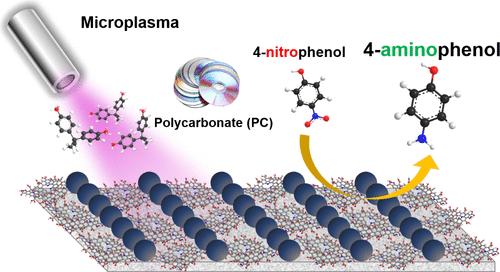具有极端催化活性的紧凑圆盘衍生纳米碳负载催化剂
IF 8.2
2区 材料科学
Q1 MATERIALS SCIENCE, MULTIDISCIPLINARY
引用次数: 0
摘要
先进的碳-金属杂化材料具有可控的电子和光学性能以及化学反应性,在能量转换与存储、催化和环境保护等新兴应用领域受到了广泛关注。然而,这些材料的商业化受到几个关键问题的阻碍,包括能源密集的合成和昂贵的化学品,以及对其结构和性质的低效控制。本文报道了在环境条件下利用微等离子体制备聚碳酸酯(PC)基光盘的纳米碳金属自组装银纳米催化剂(ssn)的简单可控工程。等离子体工程催化剂表现出可控的性能,包括表面功能、亲水性、Ag+/Ag0金属态和Ag负载。合成的催化剂利用局部表面等离子体共振(LSPR)特性,增强了将致癌物质4-硝基苯酚(4-NP)快速还原为有价值的药物中间体4-氨基酚(4-AP)的催化活性,达到0.2±0.0 s - 1的高反应速率常数,仅在30 s内完成还原。ssn表现出强大的性能,在10次循环后保持高达90%的转换效率,强调了它们的稳定性和可重用性。这项工作不仅提出了一种有效的光盘废物升级回收方法,而且强调了等离子体工程纳米催化剂在环境修复中的潜力,为高效减少污染物提供了低能耗的解决方案。本文章由计算机程序翻译,如有差异,请以英文原文为准。

Compact Disc-Derived Nanocarbon-Supported Catalysts with Extreme Catalytic Activity
Advanced carbon–metal hybrid materials with controllable electronic and optical properties, as well as chemical reactivities, have attracted significant attention for emerging applications, including energy conversion and storage, catalysis and environmental protection. However, the commercialization of these materials is hampered by several vital problems, including energy-intensive synthesis and expensive chemicals, and inefficient control of their structures and properties. Herein, we report the simple and controllable engineering of nanocarbon–metal self-assembled silver nanocatalysts (SSNs) derived from polycarbonate (PC)-based optical discs using microplasmas under ambient conditions. The plasma-engineered catalysts exhibited controlled properties including surface functionalities, hydrophilicities, Ag+/Ag0 metallic states, and Ag loading. The synthesized catalysts leverage localized surface plasmon resonance (LSPR) properties, enabling enhanced catalytic activity for the rapid reduction of carcinogenic 4-nitrophenol (4-NP) to the valuable pharmaceutical intermediate 4-aminophenol (4-AP), achieving a high reaction rate constant of 0.2 ± 0.0 s–1 and completing the reduction in just 30 s. Demonstrating robust performance, the SSNs maintained up to 90% conversion efficiency after ten recycling cycles, underscoring their stability and reusability. This work not only presents an effective approach to upcycling optical disc waste, but also highlights the potential of plasma-engineered nanocatalysts in environmental remediation, offering a low-energy solution for high-efficiency pollutant reduction.
求助全文
通过发布文献求助,成功后即可免费获取论文全文。
去求助
来源期刊

ACS Applied Materials & Interfaces
工程技术-材料科学:综合
CiteScore
16.00
自引率
6.30%
发文量
4978
审稿时长
1.8 months
期刊介绍:
ACS Applied Materials & Interfaces is a leading interdisciplinary journal that brings together chemists, engineers, physicists, and biologists to explore the development and utilization of newly-discovered materials and interfacial processes for specific applications. Our journal has experienced remarkable growth since its establishment in 2009, both in terms of the number of articles published and the impact of the research showcased. We are proud to foster a truly global community, with the majority of published articles originating from outside the United States, reflecting the rapid growth of applied research worldwide.
 求助内容:
求助内容: 应助结果提醒方式:
应助结果提醒方式:


